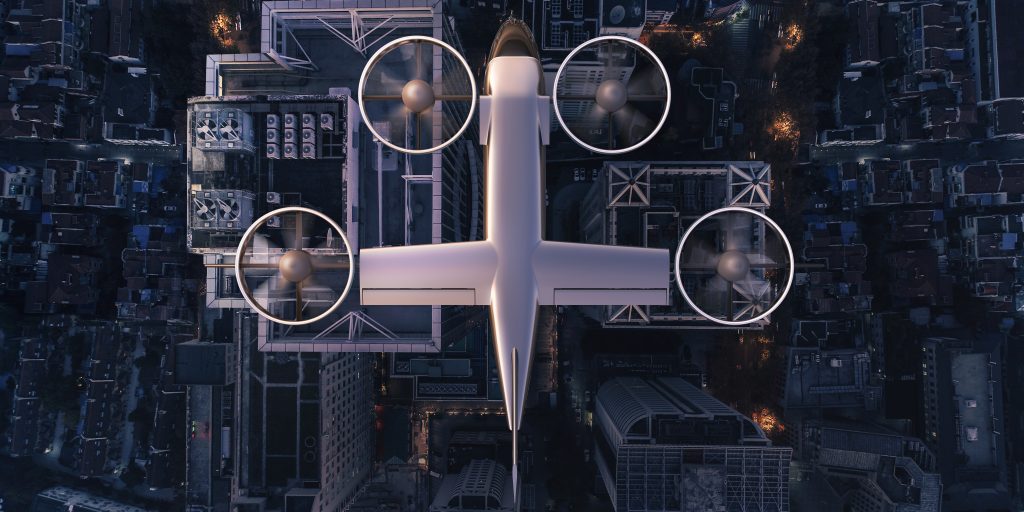Unlocking mobility’s third dimension
The vast majority of travel in today’s cities is done via personal vehicles, rideshare services, buses and trains. What these modes of transportation all have in common is that they can only travel among a single plane in two-dimensional space. But what if we had vehicles that could take advantage of that third dimension, though? What would they look like, and how would these vehicles change the way we organize our cities and our lives?
Bell, one of the world’s leading aircraft manufacturers think they’ve come up with a vehicle that can help city leaders radically rethink transportation through urban environments. Called the Nexus, this electric autonomous air taxi will shuttle passengers through the sky on demand. Think this sounds a little too much like The Jetsons? That’s because it is.
This past December, Bell invited American City & County to their Dallas headquarters where we got to learn about the Nexus first-hand. Afterward, Editor Derek Prall sat down with Scott Drennan, Bell’s vice president of innovation to discuss the Nexus and what personal air travel means for the city of the future. Drennan had just come back from the Consumer Electronics Show in Las Vegas where the Nexus was showcased.
Derek Prall: So, maybe that’s a good place to start – your panel discussion at CES with the mayors, with the innovation folks. What were people’s initial reactions to this vehicle, what did they think it would take to see these flight systems come to fruition?
Scott Drennan: We were trying to have a different mix on the panels this year in order to truly listen to what we believe is
the full stakeholder set. We summarized that simply as we are offering a technology that will change your mobility life, that will simplify your mobility life, and the technology isn’t just the vehicle – the technology is the integration of the vehicle and a city’s physical and digital infrastructures. It’s more than the sum of its parts.
Prall: Sure, not to downplay the significance of the vehicle itself – building a vehicle is great, but the ability to actually utilize that vehicle in a smart way, to take advantage of what these types of vehicles can do – that’s the crux of this.
Drennan: I agree. That’s why we’ve decided to release AirOS, our aerospace operating system. We realize the best vehicle of all, if it doesn’t have the right digital framework to fly within and the right physical infrastructure to arrive and depart from, it would be able to do anything for us. That was one of the big points – let’s start listening to the needs in those categories.
Some of the high points – the first was a very tactical learning moment for everybody, and that is cities have five to 10-year planning cycles. Urban planners are thinking in five to 10-year chunks. When you start to match that up with things that we’re saying like, “we think we can have a certified vehicle by 2028,” that means the time to start all of the urban planning is now. Of course, we’ll do a crawl-walk-run approach where we can start with existing infrastructure and a really simple network of mobility centers, but it’s going to take a lot more planning to solidify what you might need at the back end. If you don’t start doing that now, you’re going to have vehicles that are ready with nowhere to go.
We need to make sure the 2D infrastructure needs to be properly set up to meet with the 3D infrastructure. If the 3D node is five miles away from the best 2D node, that doesn’t make much sense. You need these spaces to overlap and accommodate both modes of transportation. Then, of course, any of the ground-based radar or relative GPS or 5G cellular capability that we think we might use to make autonomous flight safer and more connected, that infrastructure needs to be laid out now.
The next piece, which was pretty much across the board, was how do we reach the biggest segment the community possible? We know with technology oftentimes it’s the more economically comfortable clientele that starts these new systems off. We don’t want that to happen and not have a vision to reach a broader set of the community. That was important to have the different stakeholders at the table because that’s a sort of private/public type of partnership. We need to start asking what local, state and federal governments’ roles would be in shoring up cost structures to reach the widest possible customer set. We all know a lot of public transportation today is subsidized, so is that applicable to the air taxi portion of this, is it going to become part of the public transportation infrastructure or is it private entities that need to work in cooperation with the community in order to put down private infrastructure in order to meet customer needs? I think the cities are calling on us to find solutions that involve underserved parts of their communities.
Prall: That leads me well into my next question – and this was something we discussed in Dallas – what do you see as the most likely scenario for the rollout of this? Would these be privately owned vehicles working in conjunction with existing transportation systems? What do you think is the most realistic scenario?
Drennan: I’m getting customer feedback from both sides of that equation at equal levels. There’s a big demand from the private sector of rideshare, but I’m getting certain cities coming to me asking if we can make this a part of what they’re doing already. Our position is being ready for both of those customer asks because of the number of requests that are happening on both sides. If you had to pin it down and name it, it feels like the classic private-public – not either or – because there are too many stakeholders on both sides. Even if private industry takes the lead, I can’t imagine that happening without public conversations taking place. The FAA has to be involved to get the vehicles certified and the airspace management system certified. Then you’re landing the aircraft, which switches the purview to local governments and the departments of transportation. Then when people leave the vehicles and start to interface with bikes or scooters, cars trains or buses, or even their own feet on the sidewalk you’re into the heart of the departments that regulate these systems. I think we’re going to have private-public partnerships just because of the level of integration that’s required.
When you think about the timeline – mid-to-late 2020s – if you think about that timeline relative to the preparations cities need to undergo, that’s when you can start talking about a complete system. Everybody wants it faster – some are claiming they can do it – but how much is going to be ready in these smart cities? It’s great if there’s one or two nodes, we definitely need to start there, but the real system that truly can change people’s lives is out in that future space.
Prall: We’ve kind of brought this up in passing, but I wanted to ask you directly. We know these urban planning cycles are on slower, more methodical timelines. With that in mind, what would you say are the top things planners and leaders need to be thinking about right now to fully utilize and leverage these types of systems in the future? When we say we need to start planning now, what do we need to be considering?
Drennan: So first, I’ve called this in a lot of my talks “right-sized physical infrastructure.” You need a 50-foot by 50-foot pad for one vehicle to operate. We think a true mobility center has five to 10, maybe even more pads. So right-sizing that physical place is really important. It’s not just about the physical dimensions that the vehicle needs for landing and takeoff, but the maintenance that needs to be done. Does this place have a facility, or will you have to take the vehicles off sight?
But drop down from that for a moment, we need to ask ourselves what are these mobility centers? Are they stuffy buildings with 20 elevator shafts where you go out and take your ride? We say no – these are residential buildings. These are retail buildings. These are living centers that have great mobility. Not mobility centers that whether you wanted to be there or not was an afterthought. It’s first creating a place where people want to go and be together as a community, and then it’s a place that is ultimately so well connected you can get there and leave with ease.
So that’s the physical piece. Then we need to consider the power grid. The lifeblood is the power coming in to charge the vehicles. And that would be charging of ground electric vehicles, air electric vehicles – all the safety and sustainability regulatory pieces that go with that.
Then the 2D infrastructure needs to be ready. If we have this great living mobility center and it’s just a trap for traffic jams and congestion, it won’t be good for anyone. We need a robust ground structure to support flights as well. Digital infrastructure needs to be considered – and this is where we can help cities. We need to talk about if 5G communication is a viable component of the air mobility sector. Do we need ground radar to help them fly?
The final piece that’s really important is to think about the safe operation of these physical infrastructure upgrades. What kind of redundancy is available? Cities have issues – there could be a ground accident that could impact the center’s operation. Is it cybersecure so we don’t have nefarious actors getting into our transportation systems? Natural disaster – what kind of thinking do we have about storms and power outages? What happens to this piece of infrastructure in the event of an emergency. Do we need redundancy in the pads themselves? If you have to divert, where would you go? That’s a pretty big list, but that’s what we were talking about.
Prall: Now we get to the fun part where we can speculate a little bit. In discussing this story, one of the things that stood out to me is that this isn’t just another form of transportation. It’s not just a novel idea. These vehicles are going to open up 3D space and change the way we think about the organization of our urban landscapes. Can you talk about what some of those changes might look like?
Drennan: I think that’s a really fun conversation – I’ll do it in two ways. Let’s start by thinking about having certain cities in certain locations with a lot of infrastructure already in place that expands out not only from the city core but out into the suburbs and even into the surrounding rural areas. In that case, I think we might have to prepare ourselves for businesses really reconsidering who their customer bases are, and who they can reach because now suddenly you have a flying people-moving device, and a flying goods-moving device and a flying data-moving device that you can add to your decision making. If I want to live in Dallas but work in Fort Worth, suddenly I have a flying transportation option that makes that trip in 10 minutes rather than 45 sitting in traffic.
Beyond that – think about emergency medical services. What do they look like today, and what would you be able to do with an on-demand, all-electric fleet of flying vehicles at your disposal? It’s incredible to think about.
Do you have geography around you that’s all but restricted development that suddenly the air piece could unlock because you don’t have to build a giant highway or a massive bridge across a bay? You can now just go for it because you have an as-the-crow-flies solution of getting people and things there.
The next piece, that’s even more fun, is what would a city look like if you could start with a clean slate of greenspace and start from the ground floor with these new mobility options in mind. Maybe that leads to less roads and less ground travel because the air piece is built-in right from the beginning. You could have paired cities all up and down the east coast with this new type of infrastructure. Given all of the upcoming mobility options that a non-existent city could think about, how would you create that city from the get-go? What would be more walkable, what would be flyable, what would be ground transportation and what would be underground transportation?
Prall: Moving people through three dimensions rather than just two – I think it’s a really interesting concept. We have the technology – we can do this, it’s just a matter of how and when and how do we do that best, right?
Drennan: And having everybody really want to do it – people have reservations about noise and safety and the cost. We’re obviously trying to create technologies that address all of those. One of the things that came up in these panels is that we need to do really good communication to let people know that it’s out there, that it’s coming, that it’s possible, so they can influence the people in their communities. We need to do outreach – which is different than communication – outreach is going to these places and showing people what it means and what it would look like.




















